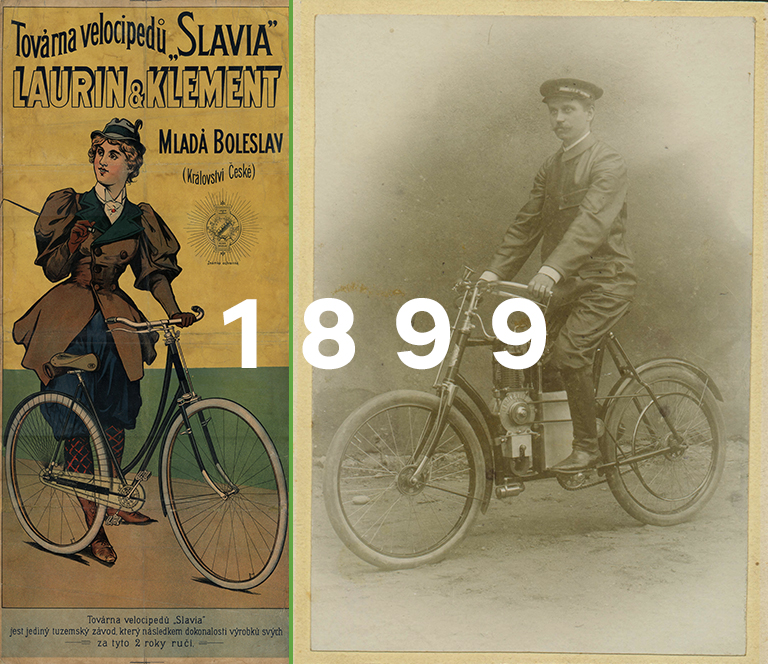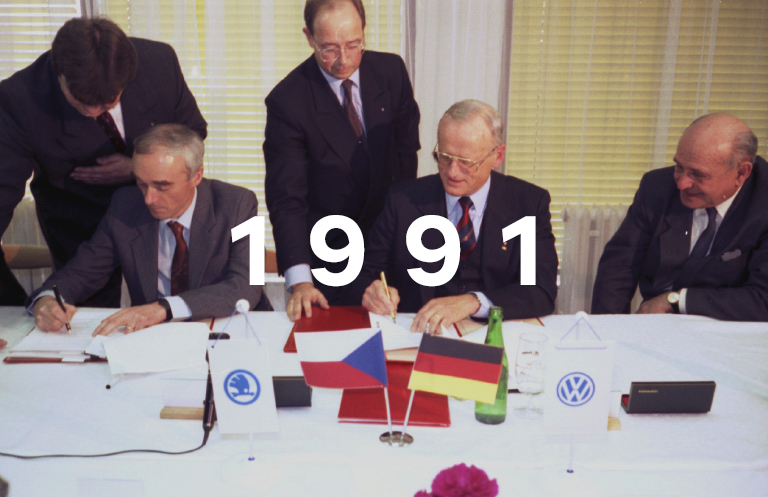125 years of ŠKODA: fundamental changes

One reason for the success of ŠKODA is the countless transformations the company has gone through at various levels during its 125-year existence. Let’s take a look back at some truly fundamental transformations.
25. 2. 2020 125 let Škode1895
From repairing bicycles to making them

Locksmith Václav Laurin and the three years younger bookseller Václav Klement were united by a passion for cycling and a desire to produce their own bicycle, made from the best materials available, high-quality, durable, yet affordable. They started out before Christmas in 1895 in a small repair shop in Mladá Boleslav with five employees. Just a year later they were already offering five SLAVIA bicycle models made by 21 employees. But that was just the start of countless new models and services for customers that were to follow.
1899
From bicycles to motorcycles

The two founders soon wanted more than just a wide range of bicycles, from models for children and women to tandems, bicycles with either chain or shaft drive systems, and even tricycles for transporting goods. In 1899 they replaced pedal power with a compact petrol engine. After painstaking experimentation, the talented technician Laurin became the first in the world to hit on the ideal placement of the power unit on the lower part of the frame. Right from the start, customers could choose between two designs offering a power output of either 0.9 kW or 1.3 kW.
1905
From two wheels to four

In the heyday of the LAURIN & KLEMENT motorcycle era, the constructors initiated another, literally revolutionary change – their own automobile. The light but speedy new car called the L&K VOITURETTE A was powered by a two-cylinder one-litre engine that could deliver a top speed of 40 km/h. Like its motorcycle brothers, it sold well at home and abroad. Soon afterwards, the firm’s constructors had designed four-cylinder and luxury eight-cylinder engines, and L&K cars were notching up one success after another, in terms of both sales and wins on the racetrack. The marque had become the biggest motor works in the Austro-Hungarian Empire. As in the case of its motorcycles, the company relied only on its own development work to make cars rather than production under licence.
1925
Under the new name ŠKODA

After two decades of expansion, the company was rocked by the shockwaves of World War I and the collapse of traditional markets, including its domestic market, which shrank from an empire of 53 million people to the Czechoslovak Republic with just one fifth of that population. What’s more, production in the factory was paralysed by a fire. These factors led to a decision to find a strategic partner. LAURIN & KLEMENT found one in one of the biggest machine engineering and armaments firms in Central Europe, the Pilsen-based giant ŠKODA with French co-owners. A mutually beneficial partnership was formed. The winged arrow in the logo symbolised speed and progress – ideal for the Mladá Boleslav motor works.
1929
The switch to production lines

From 1927 to 1929, the foundations of efficient production lines were laid, benefiting from standardisation, with parts that could be used in multiple vehicles, and specialisation, with employees focusing on a particular activity. The most modern production line in Czechoslovakia was inspired by the USA and was intended for a new generation of ŠKODA automobiles. It went into operation shortly before the Wall Street Crash. The far-sighted and thorough transformation of the company enabled it to avoid the kind of collapse that affected many of its competitors. A few years later, ŠKODA even came out of the crisis stronger.
1934
Backbone replaces ladder frames

The radical modernisation of production technology making it possible to increase the factory’s capacity while improving efficiency was logically followed by another step: the development of an entirely new generation of automobiles. Their progressive design brought major reductions in vehicle weight, which saved hundreds of kilograms of material and delivered other benefits like lower fuel consumption, lower price, slower tyre wear and better handling properties. The ŠKODA POPULAR, RAPID, FAVORIT and SUPERB family of cars was built on a central chassis backbone that replaced the conventional rectangular frame resembling a horizontal ladder. Fixed axles that caused the wheels to bounce around on uneven surfaces made way for independent suspension that came as standard on even the marque’s cheapest models.
1945
From private ownership to a state firm

The Mladá Boleslav motor works became a public company before World War II, which brought an injection of money for investment. But after the war, major industrial, financial and other companies were nationalised in Czechoslovakia, as in a number of other European countries. What’s more, the firm was renamed. From 1 January 1946 its official name became AZNP, which stood for Automobilové závody národní podnik (“motor works state firm”). All important decisions about investments, manufacturing, pricing and other key matters began to be taken by the state.
1952
From timbering to all-metal bodies

1952 brought one of the biggest changes in AZNP’s manufacturing technology, removing a major obstacle to genuine mass production. After almost half a century, the bell tolled for joiners who prepared the timbering for the body’s load-bearing frame. An all-metal structure welded together from pressed sheet metal parts was first used on the ŠKODA 1200, which was the culmination of four years’ intensive development. The body design also changed to an exterior pontoon body with integrated mud-flaps and a wider interior than before. Passenger cars were followed by light utility vehicles, including the typical ambulance designs from the Kvasiny plant.
1964
Engine moves from front to rear

A new part of the production plant at Mladá Boleslav was officially opened in March 1964. It was equipped with state-of-the-art technologies that made it possible to increase annual production levels from around 40,000 vehicles to 100,000 and more. The product itself was completely overhauled as well, though. The classic design with an engine mounted at the front and powering the rear wheels by means of a long shaft gave way to a much more compact, simple and light “all at the rear” design. The space under the front hood could thus be used for luggage. The greater weight on the driving wheels brought advantages when going uphill on snow, for example: and the ŠKODA 1000 MB was born. The rear-engine design remained in production until 1990.
1987
An entirely new concept

It’s no exaggeration to say that 1987 brought a revolutionary change in the company’s history. With its modern design, the new FAVORIT model met the demands of customers on even the most demanding markets. Concentrating the engine and transmission at the front driving wheels was in line with the trends of the day. What’s more, it paved the way for a larger number of body design versions and engines as well. This brand new generation of ŠKODA vehicles was pioneered by the FAVORIT hatchback, followed by the FORMAN estate and PICK-UP utility vehicle. These were the result of the company’s own development, with specific input from specialised collaborating firms, including Porsche or the Italian Bertone design studio.
1991
Joining Volkswagen

The fall of the Iron Curtain in 1989 led to fundamental social changes, and Czechoslovakia’s centrally managed command economy became a thing of the past. The difficult process of privatisation got underway. In the first phase the state, as the owner, launched the transformation of the company into a public company, to be bolstered by a strong strategic partner. The best bid, which guaranteed the preservation of the traditional Czech ŠKODA marque and its own development department, came from Volkswagen, which was then the biggest automobile manufacturer in Europe. The agreement was finally signed on 16 April 1991. Over the following nine years, Volkswagen came to hold a 100% stake in the firm. By then, ŠKODA was already manufacturing more than 2.5 times the production volume from the pre-privatisation era.
2009
From estates to SUVs

ŠKODA responded to the growing popularity of sports utility vehicles, known as SUVs, by developing the excellent and successful YETI model in spring 2009. In construction terms it was based on the popular OCTAVIA line, or more precisely on the raised-height outdoor OCTAVIA SCOUT chassis platform. The YETI’s success was followed up by other SUVs bearing the winged arrow logo: the ŠKODA KODIAQ (2016), KAROQ (2017) and KAMIQ (2018). When making SUVs, ŠKODA could draw on years of experience – back in 1966 it took part in a project initiated by its representative in New Zealand, gave rise to the rugged and robust TREKKA, based on the OCTAVIA Super of the time.
2016
From analogue technologies to digitisation

ŠKODA is the Simply Clever Company for best mobility solutions. It is pressing ahead with the digital transformation across the entire business at full speed, intensifying our efforts in Industry 4.0 and connected vehicles. At the same time, ŠKODA is opening up to collaborating with cities with regard to smart mobility as well as micromobility. That is the reason why ŠKODA established ŠKODA AUTO DigiLabs. These creativity hubs based in Prague, Beijing, Tel Aviv and Pune in India are flexible platforms which research and develop new business models and mobility solutions. Collaborating with promising start-ups, ŠKODA AUTO DigiLab developed for example the Citymove app or the car-sharing project HoppyGo or the scooter-sharing platform BeRider. Digitisation also represents a change in culture throughout ŠKODA, so it involves more than “just” the digitisation of the actual production process, with increasing use of automation and artificial intelligence. ŠKODA is transforming itself from a mass producer of automobiles into a provider of comprehensive mobility services.
2019
From combustion engines to plug-in hybrids and electric vehicles

In Mladá Boleslav, the tradition of developing and manufacturing combustion engines stretches all the way back to 1899. The original fuel – petrol – was gradually joined by diesel, and even wood gas and coal gas, while the modern era has seen the addition of LPG and compressed natural gas, known as CNG, as alternative fuels. In 2019 ŠKODA entered the era of eMobility – a very special event in the history of the company. The launch of the SUPERB iV and CITIGOe iV marked the start and we are now gradually electrifying our entire model line-up. The new OCTAVIA including plug-in-hybrid version followed and celebrated its world premiere in November 2019. In 2020, ŠKODA will present the first all-electric model based on the MEB platformof the Volkswagen Group, the ŠKODA ENYAQ. In total more than ten electrified ŠKODA models will be introduced between 2019 and the end of 2022. Under the iV sub-brand, ŠKODA develops a complete ecosystem around the car for the customers: providing them with an intelligent search function to find charging stations, wall boxes for convenient charging at home and the ŠKODA e-Charge Card for easily recharging their cars on the road.
























